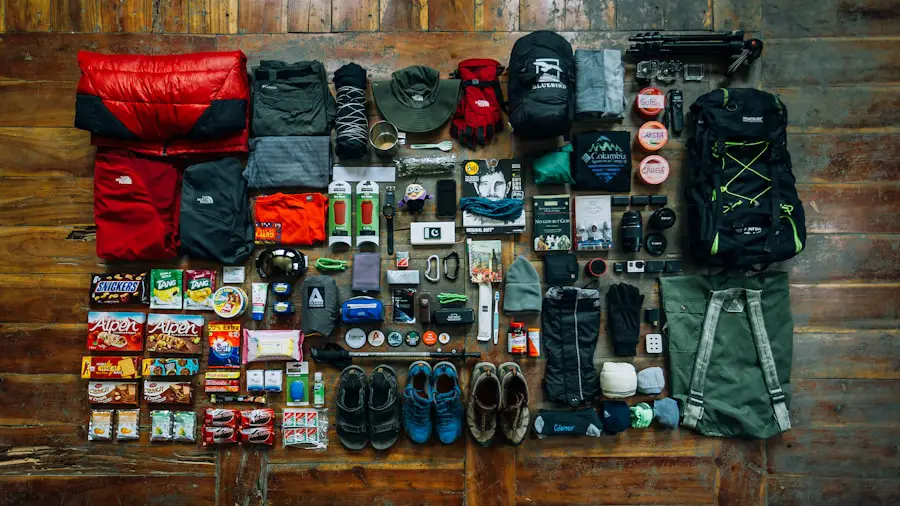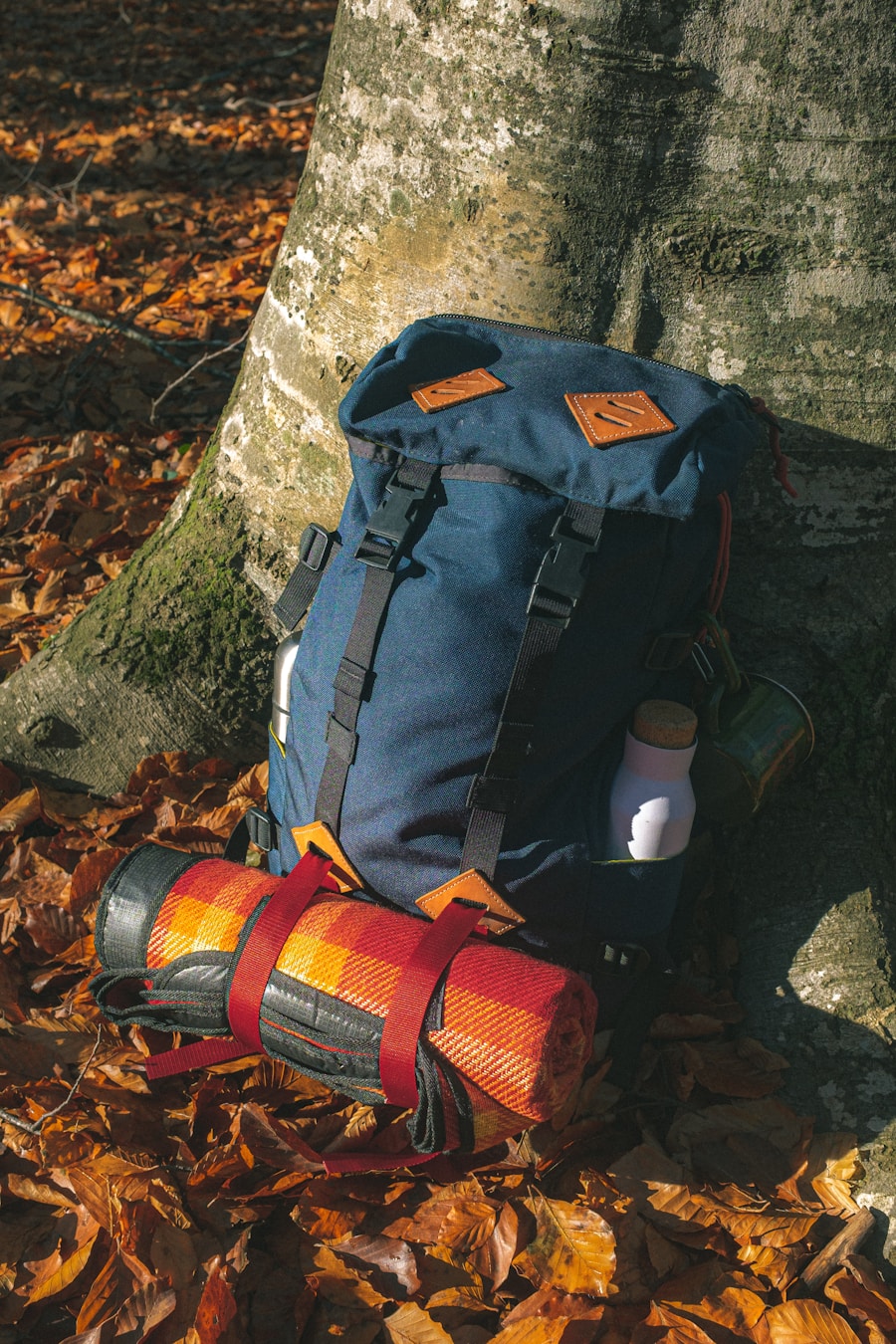A properly fitting hiking backpack is crucial for an enjoyable and safe outdoor experience. When a backpack fits well, it allows for better weight distribution, which can significantly reduce fatigue and discomfort during long hikes. An ill-fitting backpack can lead to a range of issues, including back pain, shoulder strain, and even blisters.
The importance of a well-fitted backpack cannot be overstated; it is the difference between a pleasant day on the trails and a painful ordeal that could cut your adventure short. Moreover, a correctly fitted backpack enhances your overall stability and balance while navigating uneven terrain. When the weight is distributed evenly across your body, you are less likely to experience fatigue or strain, allowing you to maintain your energy levels throughout your hike.
This is particularly important when traversing steep inclines or rocky paths, where maintaining balance is essential for safety. A well-fitted backpack not only improves your comfort but also contributes to your overall performance on the trail.
Key Takeaways
- Properly fitting your hiking backpack is crucial for comfort and safety on the trail.
- Understanding your body measurements, such as torso length and hip size, is essential for choosing the right size backpack.
- Choosing the right size and type of backpack based on your body measurements and hiking needs is important for a comfortable fit.
- Adjusting the shoulder straps and hip belt to distribute weight evenly and ensure proper support is key for a well-fitted backpack.
- Properly distributing weight in your backpack and ensuring comfort and balance will prevent strain and discomfort during your hike.
Understanding Your Body Measurements
To find the perfect fit for your hiking backpack, it is essential to understand your body measurements. The most critical measurements include your torso length, hip circumference, and shoulder width. Torso length is typically measured from the base of your neck to the top of your hip bones.
This measurement helps determine the size of the backpack’s frame and how it will sit on your body. Many manufacturers provide sizing charts that correlate torso length with specific backpack sizes, making it easier to find a suitable option. In addition to torso length, knowing your hip circumference is vital for selecting a backpack with an appropriate hip belt.
The hip belt is designed to transfer weight from your shoulders to your hips, which is crucial for comfort during long hikes. To measure your hip circumference, wrap a measuring tape around the widest part of your hips while standing upright. This measurement will help you choose a backpack that provides adequate support and stability, ensuring that the weight of your gear is distributed effectively.
Choosing the Right Size and Type of Backpack

Once you have a clear understanding of your body measurements, the next step is to choose the right size and type of backpack for your hiking needs. Backpacks come in various sizes, typically categorized as small, medium, large, and extra-large. Each size corresponds to specific torso lengths and capacities, so it’s essential to select one that aligns with your measurements and intended use.
For instance, if you plan on embarking on multi-day hikes, a larger capacity backpack may be necessary to accommodate additional gear and supplies. In addition to size, consider the type of backpack that best suits your hiking style. There are several categories of hiking backpacks, including daypacks, overnight packs, and multi-day packs.
Daypacks are generally smaller and designed for short hikes or day trips, while overnight packs are suitable for one or two-night excursions. Multi-day packs are larger and equipped with features that support extended trips, such as additional compartments for food and gear. Understanding the purpose of your hike will guide you in selecting a backpack that meets your specific requirements.
Adjusting the Shoulder Straps and Hip Belt
| Adjustment | Percentage of Users |
|---|---|
| Adjusted Shoulder Straps | 85% |
| Adjusted Hip Belt | 78% |
| Both Shoulder Straps and Hip Belt Adjusted | 65% |
After selecting the right size and type of backpack, the next step involves adjusting the shoulder straps and hip belt for optimal fit. The shoulder straps should be snug but not overly tight; they should allow for some movement without slipping off your shoulders. When adjusting the straps, ensure that they sit comfortably against your shoulders without digging in or causing pressure points.
A good rule of thumb is to have about one to two inches of space between the straps and your shoulders. The hip belt plays a crucial role in weight distribution and should be positioned comfortably around your hips. When adjusting the hip belt, it should sit on top of your hip bones rather than resting on your waist.
This positioning allows for better weight transfer from your shoulders to your hips, reducing strain on your upper body. Additionally, ensure that the hip belt is snug enough to provide support but not so tight that it restricts movement or circulation.
Properly Distributing Weight in Your Backpack
Weight distribution within your backpack is just as important as achieving a proper fit. A well-packed backpack can significantly enhance comfort and stability while hiking. The general principle is to place heavier items closer to your back and higher up in the pack.
This positioning helps maintain your center of gravity and prevents you from feeling off-balance as you navigate various terrains. In addition to placing heavier items strategically, consider using packing cubes or compression sacks to organize gear within your backpack. This organization not only makes it easier to access items but also helps prevent shifting during movement, which can lead to discomfort or instability.
Distributing weight evenly across all compartments will further enhance balance and make carrying the load more manageable.
Ensuring Comfort and Balance

Comfort is paramount when it comes to hiking backpacks, as discomfort can quickly turn an enjoyable hike into a painful experience. To ensure comfort, pay attention to padding on the shoulder straps and hip belt; adequate cushioning can make a significant difference during long treks. Additionally, consider the material of the backpack; breathable fabrics can help reduce sweat buildup and increase overall comfort.
Balance is equally important when carrying a loaded backpack. A well-balanced pack allows for easier maneuverability and reduces strain on your body. To achieve balance, regularly check that all items are packed securely and evenly distributed within the compartments.
If you notice any shifting or unevenness while hiking, take a moment to readjust the load before continuing on your journey.
Testing and Readjusting Your Backpack Fit
Before embarking on a long hike, it’s essential to test and readjust your backpack fit as needed. Take time to walk around with the loaded pack in a controlled environment—such as your backyard or a local park—to assess how it feels during movement. Pay attention to any areas of discomfort or pressure points that may arise during this test run.
If you notice any issues during testing, don’t hesitate to make adjustments. It may take several iterations of adjusting straps and redistributing weight before achieving the perfect fit. Remember that comfort is subjective; what works for one person may not work for another.
Therefore, take the time necessary to ensure that your backpack feels just right before hitting the trails.
Tips for Maintaining a Properly Fitted Backpack
Maintaining a properly fitted backpack goes beyond initial adjustments; it requires ongoing attention throughout its lifespan. Regularly inspect the straps and hip belt for signs of wear or damage that could affect fit and comfort. If you notice any fraying or loosening of components, address these issues promptly to prevent further deterioration.
Additionally, consider periodically re-evaluating your fit as you gain or lose weight or change physical condition over time. Your body may change due to various factors such as fitness levels or seasonal clothing adjustments; therefore, it’s wise to reassess how your backpack fits periodically. By staying proactive about maintenance and adjustments, you can ensure that your hiking backpack continues to provide optimal support and comfort for all your outdoor adventures.
If you’re looking to upgrade your hiking gear, you may also want to consider investing in the best solar charger for backpacking. Having a reliable solar charger can keep your devices powered up while you’re on the trails, ensuring you stay connected and safe during your outdoor adventures. It’s just as important as finding the right hiking backpack to fit all your essentials.
FAQs
What is a hiking backpack?
A hiking backpack is a type of backpack specifically designed for carrying gear and supplies during hiking or trekking trips. It is designed to be comfortable, durable, and able to carry heavy loads for extended periods of time.
How do I choose the right size hiking backpack?
When choosing a hiking backpack, consider the length of your trip and the amount of gear you need to carry. A general guideline is to choose a backpack with a capacity of 30-50 liters for day hikes, 50-65 liters for overnight trips, and 65+ liters for multi-day hikes.
What features should I look for in a hiking backpack?
Look for features such as adjustable shoulder straps, padded hip belts, ventilation systems, multiple compartments, hydration compatibility, and durable materials. These features will ensure comfort, organization, and functionality during your hike.
How should a hiking backpack fit?
A hiking backpack should fit snugly against your back with the weight evenly distributed on your hips. The shoulder straps should be adjustable and the hip belt should sit comfortably on your hips to support the weight of the pack.
How do I properly pack a hiking backpack?
When packing a hiking backpack, place heavier items closer to your back and towards the bottom of the pack. Keep frequently used items in easily accessible pockets and distribute the weight evenly to maintain balance and stability.
